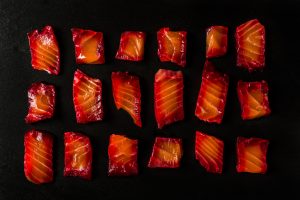Turkish Delight, when made well, harnesses all the delicate, but powerful flavours of the rose. It’s probably most people’s first experience with actually tasting a flower, even if it is from an essence. The thing is, we’re not exposed to many dishes or foodstuffs that are comprised of flowers and so the concept can be somewhat alien to many. However, the restaurant environment provides diners with comfort and assurance that what they’re being fed will work, will be delicious, will reveal something new. It’s this element of surprise, of control, that makes the dining room such an exciting place, and ripe for exploring flavours of a floral nature.
Calendula flowers, or marigolds to you and me, offer vibrant freshness with a subtle citric twang. The flowers are often arranged throughout a salad of crisp leaves and very little dressing, but they can also be used to create a knockout pesto. Piquillo peppers, Marcona almonds, sherry vinegar, and large handfuls of calendula flowers blitz down to a delicious pesto, just be sure to use a mild flavoured rapeseed or olive oil, too much pepperiness in the oil can quickly overwhelm the other flavours.
Another way to utilise edible flowers and let them take centre stage in a dish is with things like yogurts, sorbets and ice creams. Unadorned milks carry a certain clarity that allows apple blossoms and wild pea flowers to stand out in a sharp, crisp and delicious way. Of course, decorating cakes with sugar-crystallised petals is a classic use of edible flowers, but you can also infuse them into a huge range of tinctures and tonics. Syrups made from primrose, pansies, blue ocean flowers and even orchids can equip you with a nuanced range of floral flavours that can elevate dishes higher than their ordinary counterparts.
While you’re probably no newcomer to the delights of elderflower cordial and wine, know that the practice can be demonstrated with a whole host of other seasonal flowers. Hibiscus, which is made into a cordial in Mexico known as Jamaica, is ideal for syrups and teas, but rather than trying to extend it’s flavours with red berry fruit, instead choose herbs like rosemary for a balanced but dynamic flavour combination that can be used against all manner of light, palate cleansing dishes.
The shiso leaf, though not an actual flower, is used throughout Japanese cookery, particularly in the presentation of sashimi. This minty, peppery, slightly citric leaf can be used as a vessel to carry a range of flavours from veal tartare, to arancini style fritters.
In preparing flowers for cooking, be sure to remove the heel of the petal as this can often carry bitter notes, which can be passed onto your bar staff to create aromatic bitters for their drinks.
However you plan to play with our abundant range of edible flowers, be sure to concentrate on their preparation and allow them to take centre stage in a dish. Working with floral flavours requires a deft hand in order to balance against other flavours and ingredients – a skill that sets apart the amateurs from the pros.


